Uzbekistan | Bukhara | The Poet Rudagi

When I woke up unexpectedly at three a.m. last night it suddenly dawned on me that I have not said nearly enough about the Samanids, who ruled Bukhara from c.875 to 999 a.d. Bukhara, under Samanid rule, was the Focus of Splendour, the Shrine of Empire, the Meeting-Place of the most unique intellects of the age, the Horizon of the literary stars of the World, and the Fair of the great scholars of the Period. So intoned historian Abu Mansur Abdu l-Malik ath-Thaalibi (961–1038), who as a young man was privileged to sit at the feet of the savants of Bukhara. One literary star of the time was Rudagi (858–c.941), who was born in a village near Samarkand on the middle Zerafshan River (some say a village near Panjakant, in current-day Tajikistan). According to some accounts, he was blind from birth or early childhood, although this has been disputed. He flowered early as a poet and as a lyricist who may have sung his effusions and accompanied himself on the harp. He was soon notice...





